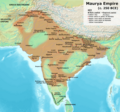File:Maurya Empire, c.250 BCE.png

預覽大細:642 × 600 像素。 第啲解像度:257 × 240 像素|514 × 480 像素|822 × 768 像素|1,200 × 1,121 像素。
原本檔案 (1,200 × 1,121 像素,檔案大細:2.3 MB ,MIME類型:image/png)
檔案歷史
撳個日期/時間去睇響嗰個時間出現過嘅檔案。
| 日期/時間 | 縮圖 | 尺寸 | 用戶 | 註解 | |
|---|---|---|---|---|---|
| 現時 | 2024年1月29號 (一) 02:15 |  | 1,200 × 1,121(2.3 MB) | Avantiputra7 | as per discussions added labelling of provinces |
| 2023年11月22號 (三) 06:40 |  | 1,200 × 1,121(2.06 MB) | Avantiputra7 | Reverted to version as of 05:59, 22 November 2023 (UTC) no justification for changing to less legible version of exactly the same map | |
| 2023年11月22號 (三) 06:14 |  | 1,500 × 1,309(2.93 MB) | Indo12122 | Reverted to version as of 05:34, 22 November 2023 (UTC) Stop hijacking. | |
| 2023年11月22號 (三) 05:59 |  | 1,200 × 1,121(2.06 MB) | Avantiputra7 | Reverted to version as of 05:06, 22 November 2023 (UTC) | |
| 2023年11月22號 (三) 05:34 |  | 1,500 × 1,309(2.93 MB) | Indo12122 | Reverted to version as of 19:00, 21 November 2023 (UTC) | |
| 2023年11月22號 (三) 05:06 |  | 1,200 × 1,121(2.06 MB) | Avantiputra7 | Reverted to version as of 18:13, 21 November 2023 (UTC) rv vandalism | |
| 2023年11月21號 (二) 19:00 |  | 1,500 × 1,309(2.93 MB) | Indo12122 | Reverted to version as of 17:53, 21 November 2023 (UTC) Adding Gedrosia .Ray, Himanshu Prabha (2003). The Archaeology of Seafaring in Ancient South Asia. Cambridge University Press. ISBN 978-0-521-01109-9. In spite of the vagueness of the historical texts, the consensus among scholars is that the treaty concluded between Candragupta Maurya and Seleucus acknowledged Indian control of territories to the west of the Indus. These included Gedrosia, Paropamisadae (the region of Kabul and Begram) a... | |
| 2023年11月21號 (二) 18:13 |  | 1,200 × 1,121(2.06 MB) | Avantiputra7 | Reverted to version as of 17:07, 21 November 2023 (UTC) no justification for changing to less legible version of exactly the same map | |
| 2023年11月21號 (二) 17:53 |  | 1,500 × 1,309(2.93 MB) | Indo12122 | Reverted to version as of 16:58, 21 November 2023 (UTC) | |
| 2023年11月21號 (二) 17:07 |  | 1,200 × 1,121(2.06 MB) | Avantiputra7 | Reverted to version as of 16:36, 21 November 2023 (UTC) |
檔案用途
無嘢連來呢份檔案。
全域檔案使用情況
下面嘅維基都用緊呢個檔案:
- en.wikipedia.org嘅使用情況
- en.wiktionary.org嘅使用情況
- hy.wikipedia.org嘅使用情況
- ko.wikipedia.org嘅使用情況
- sv.wikipedia.org嘅使用情況
- ta.wikipedia.org嘅使用情況
- zh.wikipedia.org嘅使用情況